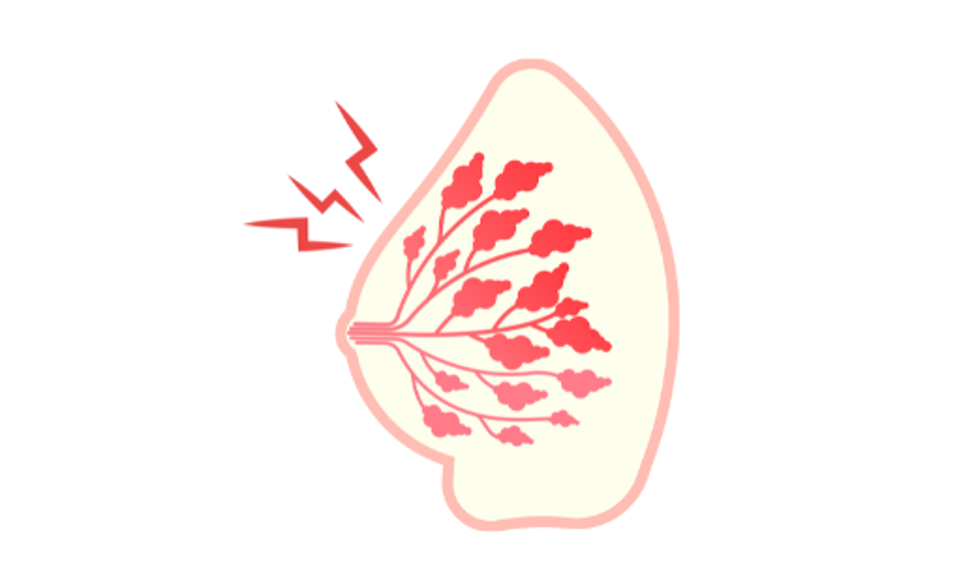Ο θηλασμός αποτελεί μια βαθιά προσωπική και μεταμορφωτική εμπειρία, που θρέφει, ενισχύει τον δεσμό και, σε ορισμένες στιγμές, μπορεί να είναι σωματικά απαιτητικός. Ανάμεσα στις πιο συχνές προκλήσεις συγκαταλέγονται η μαστίτιδα και οι φραγμένοι γαλακτοφόροι πόροι, οι οποίοι ενδέχεται να προκαλέσουν δυσφορία, φλεγμονή και να διαταράξουν τη ρουτίνα του θηλασμού. Για όσες αντιμετωπίζουν συμπτώματα μαστίτιδας, ανακούφιση μπορεί να προσφερθεί μέσω θεραπευτικών επιλογών όπως η υπερηχοθεραπεία και το λεμφικό μασάζ, που παρέχουν στοχευμένες, μη επεμβατικές λύσεις, υποστηρίζοντας την ίαση και τη συνέχιση του θηλασμού. Επιπλέον, η ενσωμάτωση φυσικών μεθόδων, όπως τα προβιοτικά, δύναται να συμβάλει στην ανάρρωση και να μειώσει τον κίνδυνο επανεμφάνισης.
Στο παρόν άρθρο, εξετάζουμε πώς λειτουργούν αυτές οι θεραπείες, πότε είναι σκόπιμο να εφαρμόζονται και πώς εντάσσονται σε μια ολιστική προσέγγιση για την υγεία του στήθους κατά τη γαλουχία.
Τι είναι η μαστίτιδα και οι φραγμένοι πόροι;
- Φραγμένοι γαλακτοφόροι πόροι: εμφανίζονται όταν η ροή του γάλακτος εμποδίζεται, προκαλώντας τοπικό πρήξιμο, ευαισθησία και, σε ορισμένες περιπτώσεις, σκληρό ογκίδιο.
- Μαστίτιδα: πρόκειται για φλεγμονή του μαστικού ιστού, συχνά λόγω λοίμωξης, η οποία μπορεί να συνοδεύεται από πυρετό, ερυθρότητα και συμπτώματα που μοιάζουν με γρίπη.
Οι καταστάσεις αυτές μπορεί να προκύψουν από παραλείψεις θηλασμού, ανεπαρκή πρόσφυση του μωρού, στενά ρούχα ή έντονο στρες. Είναι πιο συχνές στην πρώιμη λοχεία, αλλά μπορούν να εμφανισθούν σε οποιοδήποτε στάδιο της γαλουχίας.
Ποιος κινδυνεύει περισσότερο;
Η πιθανότητα εμφάνισης φραγμένων πόρων ή μαστίτιδας αυξάνεται όταν:
- Υπάρχει υπερπαραγωγή γάλακτος
- Το μωρό παρουσιάζει ρηχή ή ασυνεπή πρόσφυση
- Έχει προηγηθεί πρόσφατος απογαλακτισμός ή παραλείπονται θηλασμοί
- Υπάρχει σωματικό ή συναισθηματικό στρες
Η έγκαιρη παρέμβαση αποτελεί καθοριστικό παράγοντα για την πρόληψη επιπλοκών και τη διασφάλιση μιας άνετης εμπειρίας θηλασμού.
Φυσικές και θεραπευτικές προσεγγίσεις
- Πόνος ή ευαισθησία σε συγκεκριμένη περιοχή του μαστού
- Σκληρό ογκίδιο ή πρήξιμο
- Θερμότητα ή ερυθρότητα στην πάσχουσα περιοχή
- Πυρετός, ρίγη ή συμπτώματα γρίπης (ιδιαίτερα στη μαστίτιδα)
- Μειωμένη ροή γάλακτος ή ανησυχία του μωρού κατά τον θηλασμό
Η έγκαιρη αναγνώριση αυτών των συμπτωμάτων επιτρέπει την έγκαιρη θεραπεία και καλύτερα αποτελέσματα.
Φυσικές και θεραπευτικές προσεγγίσεις
- Θηλασμός ή άντληση
Διατηρήστε τη ροή του γάλακτος. Ξεκινήστε τον θηλασμό από την πάσχουσα πλευρά και εφαρμόστε απαλό μασάζ. Αποφύγετε την έντονη άντληση ή το βαθύ μασάζ, καθώς μπορεί να επιδεινώσουν τη φλεγμονή.
Χλιαρές κομπρέσες και κομπρέσες με άλατα Epsom
Εφαρμόστε χλιαρές κομπρέσες πριν τον θηλασμό για να μαλακώσει η περιοχή. Μετά τον θηλασμό, οι κρύες κομπρέσες βοηθούν στη μείωση της φλεγμονής.
3. Λεμφικό μασάζ
Μια απαλή, ρυθμική τεχνική που διεγείρει το λεμφικό σύστημα και συμβάλλει:
- Στην απομάκρυνση υγρών και φλεγμονωδών παραπροϊόντων: Υποστηρίζει την αποβολή της περίσσειας υγρών, των κυτταρικών αποβλήτων και των φλεγμονωδών παραπροϊόντων από τον πάσχοντα ιστό.
- Στη μείωση του οιδήματος και της συμφόρησης: Ιδιαίτερα χρήσιμο σε περιπτώσεις φραγμένων πόρων ή πρώιμης μαστίτιδας, όπου η συσσώρευση υγρών προκαλεί δυσφορία.
- Στην επιτάχυνση της ανάρρωσης και τη μείωση της ευαισθησίας: Με τη βελτίωση της κυκλοφορίας και της παροχέτευσης, το λεμφικό μασάζ μπορεί να επιταχύνει την ίαση και να μειώσει την ευαισθησία.
Σε αντίθεση με το βαθύ μασάζ ιστών, το οποίο μπορεί να επιδεινώσει τη φλεγμονή, το λεμφικό μασάζ χρησιμοποιεί ελαφριές, απαλές κινήσεις που ακολουθούν τη φυσική κατεύθυνση της λεμφικής ροής, συνήθως προς τη μασχάλη και την κλείδα.
Υπερηχοθεραπεία
Η υπερηχοθεραπεία αξιοποιεί ηχητικά κύματα υψηλής συχνότητας, τα οποία διεισδύουν βαθιά στον ιστό του μαστού. Με τον τρόπο αυτό συμβάλλει στη διάλυση των φραγμένων πόρων και στη βελτίωση της κυκλοφορίας.
- Οι συνεδρίες είναι σύντομες, διάρκειας 10–20 λεπτών
- Πρόκειται για μια μη επεμβατική και ανώδυνη μέθοδο
- Μειώνει τη φλεγμονή και ενισχύει την ταχύτερη επούλωση
5. Προβιοτικά
Οι λακτοβάκιλλοι (Lactobacillus fermentum, , Lactobacillus salivarius)διαθέτουν αντιμικροβιακή και αντιφλεγμονώδη δράση. Μπορούν να μειώσουν παθογόνους οργανισμούς όπως ο Staphylococcus aureusνα αποκαταστήσουν την ισορροπία μικροβίων και να προλάβουν τις υποτροπές.
Ενυδάτωση και ξεκούραση
Πίνετε αρκετά υγρά και δώστε προτεραιότητα στην ανάπαυση. Ένα καλά υποστηριζόμενο σώμα αναρρώνει πιο αποτελεσματικά.
Πότε να ζητήσετε ιατρική βοήθεια
Απευθυνθείτε σε γιατρό εάν:
- Εμφανίσετε υψηλό πυρετό ή ρίγη
- Τα συμπτώματα επιδεινώνονται μετά από 24–48 ώρες
- Υπάρχει πύον ή αίμα στο γάλα
- Έχετε λιποθυμικές τάσεις, ζάλη ή αισθάνεστε κακουχία
Your healthcare provider may prescribe antibiotics or recommend drainage if an abscess forms. Always consult a professional if you’re unsure.
Πρακτικά βήματα για ανακούφιση
- Επικοινωνήστε με τη μαία ή/και σύμβουλο γαλουχίας για εξατομικευμένη καθοδήγηση
- Χρησιμοποιήστε χλιαρές κομπρέσες πριν τον θηλασμό για να διευκολύνετε τη ροή του γάλακτος
- Εφαρμόστε κρύες κομπρέσες μετά τον θηλασμό για να μειώσετε τη φλεγμονή
- Συνεχίστε τον θηλασμό ή την άντληση ώστε να διατηρείται η φυσιολογική ροή
- Δημιουργήστε ήρεμο και καθαρό περιβάλλον για ξεκούραση και ανάκαμψη
- Ζητήστε ιατρική συμβουλή εάν τα συμπτώματα επιμένουν ή επιδεινώνονται
Τελικές σκέψεις
Η υπερηχοθεραπεία και το λεμφικό μασάζ αποτελούν ήπιες και αποτελεσματικές μεθόδους υποστήριξης για φραγμένους γαλακτοφόρους πόρους και μαστίτιδα. Σε συνδυασμό με προσεκτικές πρακτικές θηλασμού και συναισθηματική φροντίδα, μπορούν να μειώσουν τη δυσφορία και να ενισχύσουν την ανάρρωση.
Η κατανόηση των σημάτων του σώματος και η ανταπόκριση με συμπόνια και προσοχή κάνουν τη διαφορά στην πορεία της ίασης και στη συνολική ευεξία της μητέρας.
ανακούφιση μαστίτιδας; φραγμένοι γαλακτοφόροι πόροι; υπερηχοθεραπεία για μαστίτιδα; λεμφικό μασάζ για μαστίτιδα; φυσική θεραπεία μαστίτιδας; συμπτώματα μαστίτιδας; προβιοτικά για μαστίτιδα
Νικολέττα Λις
Μαία - Σύμβουλος γαλουχίας IBCLC
